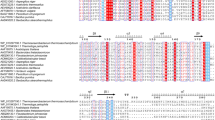Abstract
The gene encoding an α-l-arabinofuranosidase from Geobacillus caldoxylolyticus TK4, AbfATK4, was isolated, cloned, and sequenced. The deduced protein had a molecular mass of about 58 kDa, and analysis of its amino acid sequence revealed significant homology and conservation of different catalytic residues with α-l-arabinofuranosidases belonging to family 51 of the glycoside hydrolases. A histidine tag was introduced at the N-terminal end of AbfATK4, and the recombinant protein was expressed in Escherichia coli BL21, under control of isopropyl-β-D-thiogalactopyranoside-inducible T7 promoter. The enzyme was purified by nickel affinity chromatography. The molecular mass of the native protein, as determined by gel filtration, was about 236 kDa, suggesting a homotetrameric structure. AbfATK4 was active at a broad pH range (pH 5.0–10.0) and at a broad temperature range (40–85°C), and it had an optimum pH of 6.0 and an optimum temperature of 75–80°C. The enzyme was more thermostable than previously described arabinofuranosidases and did not lose any activity after 48 h incubation at 70°C. The protein exhibited a high level of activity with p-nitrophenyl-α-l-arabinofuranoside, with apparent K m and V max values of 0.17 mM and 588.2 U/mg, respectively. AbfATK4 also exhibited a low level of activity with p-nitrophenyl-β-d-xylopyranoside, with apparent K m and V max values of 1.57 mM and 151.5 U/mg, respectively. AbfATK4 released l-arabinose only from arabinan and arabinooligosaccharides. No endoarabinanase activity was detected. These findings suggest that AbfATK4 is an exo-acting enzyme.






Similar content being viewed by others
References
Bachmann SL, McCarthy AJ (1991) Purification and cooperative activity of enzymes constituting the xylan-degrading system of Thermomonospora fusca. Appl Microbiol 57:2121–2130
Bendtsen JD, Kiemer L, Fausboll A, Brunak S (2005) Non-classical protein secretion in bacteria. BMC Microbiology 5: art. no. 58
Bezalel L, Shoham Y, Rosenberg E (1993) Characterization and delignification activity of a thermostable α-l-arabinofuranosidase from Bacillus stearothermophilus. Appl Microbiol Biotechnol 40:57–62
Biely P, Mackenzie CR, Puls J, Schneider H (1986) Cooperativity of esterases and xylanases in the enzymatic degradation of acetyl xylan. Bio/Technology 4:731–733
Coutinho PM, Henrissat B (1999) Carbohydrate-active enzymes server at http://www.afmb.cnrs-mrs.fr/_/cazy/CAZY/index.html
Davies G, Henrissat B (1995) Structures and mechanisms of glycosyl hydrolases. Structure 3:853–859
Debeche TN, Cummings N, Connerton I, Debeire P, O’Donohue MJ (2000) Genetic and Biochemical characterization of a highly thermostable of α-l-arabinofuranosidase from Thermobacillus xylanilyticus. Appl Environ Microbiol 66:1734–1736
Gilead S, Shoham Y (1995) Purification and characterization of α-l-arabinofuranosidase from Bacillus stearothermophilus T-6. Appl Environ Microbiol 61:170–174
Greve LC, Labavitch JM, Hungate RE (1984) α-l-arabinofuranosidase from Rumionococcus albus 8: purification and possible roles in hydrolysis of alfalfa cell wall. Appl Environ Microbiol 47:1135–1140
Gunata ZY, Brillouet JM, Voirin S, Baume R, Cordonnier R (1990) Purification and some properties of an α-l-arabinofuranosidase from Aspergillus niger. Action on grape monoterpenyl arabinofuranosylglucosides. J Agric Food Chem 38:772–776
Henrissat B, Davies GJ (2000) Glycoside hydrolases and glycosyltransferases families, modules and implications for genomics. Plant Physiol 124:1515–1519
Lee SF, Forsberg CW (1987) Purification and characterization of an α-l-arabinofuranosidase from Clostridium acetobutylicum ATCC 824. Can J Microbiol 33:1011–1016
Manin C, Shareek F, Morosoli R, Kluepfel D (1994) Purification and characterization of an α-l-arabinofuranosidase from Streptomyces lividans 66 and DNA sequence of the gene (abfA). Biochem J 302:443–449
Margolles A, de los Reyes-Gavilan CG (2003) Purification of a novel of α-l-arabinofuranosidase from Bifidobacterium longum B667. Appl Environ Microbiol 69:5096–5103
McCleary BV (1988) Novel and selective substrates for the assay of endo-arabinanase. In Phillips GO, Wedlock DJ, Williams PA (eds) Gums and stabilisers for the food industry, vol 5. IRL, Oxford, UK, pp 291–300
Miller GL (1959) Use of dinitrosalicyclic acid reagent for determination of reducing sugars. Anal Chem 31:426–428
Miyazaki K (2005) Hyperthermophilic α-l-arabinofuranosidase from Thermotoga maritima MSB8: molecular cloning, gene expression, and characterization of the recombinant protein. Extremophiles 9:399–406
Nazina TN, Tourova TP, Poltaraus A.B, Novikova EV, Grigoryan AA, Ivanova AE, Lysenko A.M, Petrunyaka VV, Osipov GA, Belyaev SS, Ivanov MV (2001) Taxonomic study of aerobic thermophilic bacilli: descriptions of Geobacillus subterraneus gen. nov., sp. nov. and Geobacillus uzenensis sp. nov. from petroleum reservoirs and transfer of Bacillus stearothermophilus, Bacillus thermocatenulatus, Bacillus thermoleovorans, Bacillus kaustophilus, Bacillus thermoglucosidasius and Bacillus thermodenitrificans to Geobacillus as the new combinations G. stearothermophilus, G. thermocatenulatus, G. thermoleovorans, G. kaustophilus, G. thermoglucosidasius and G. thermodenitrificans. Int J Syst Evol Microbiol 51:433–446
Nielsen H, Engelbrecht J, Brunak S, von Heijne G (1997) Identification of prokaryotic and eukaryotic signal peptides and prediction of their cleavage sites. Protein Eng 10:1–6
Poutanen K (1988) An α-l-arabinofuranosidase of Trichoderma reesei. J Biotechnol 7:271–282
Saha BC (2000) α-l-arabinofuranosidase: biochemistry, molecular biology and application in biotechnology. Biotechnol Adv 18:403–423
Sambrook J, Fritsch EF, Maniatis T (1989) Molecular cloning: a laboratory manual, 2nd edn. Cold Spring Harbor Laboratory, Cold Spring Harbor, NY
Seri K, Sanai K, Matsuo N, Kawakubo K, Xue C, Inoue S (1996) Arabinose selectively inhibits intestinal sucrase in uncompetitive manner and reduces glycemic response after sucrose ingestion in animals. Metabolism 45:1368–1374
Spagna G, Romagnoli D, Angela M, Bianchi G, Pifferi PG (1998) A simple method for purifying glycosidases: α-l-arabinofuranosidase and β-D-glucopyranosidase from Aspergillus niger to increase the aroma of wine. Enzyme Microb Technol 22:298–304
Suurnakki A, Tenkanen M, Buchert J, Viikari L (1997) Hemicellulases in the bleaching of chemical pulps. Adv Biochem Eng Biotechnol 57:261–287
Ward OP, Moo-Young M (1989) Degradation of cell wall and related plant polysaccharides. Crit Rev Biotechnol 8:237–274
Whitehead TR, Cotta MA (2001) Identification of a broad-specificity xylosidase/arabinosidase important for xylooligosaccharide fermentation by the ruminal anaerobe Selenomonas ruminantium GA192. Curr Microbiol 43:293–298
Wong KKY, Sanddler JN (1993) In: Coughlan MP, Hazlewood GP (eds) Hemicellulose and Hemic°ellulases. Portland Press, London, pp 127–143
Wyman CE (1994) Ethanol from lignocellulosic biomas: technology, economics, and opportunities. Bioresour Technol 50:3–16
Acknowledgments
We are grateful to the Karadeniz Technical University Research Foundation (grant no. 24.111.004.8) for financial support.
Author information
Authors and Affiliations
Corresponding author
Rights and permissions
About this article
Cite this article
Canakci, S., Belduz, A., Saha, B.C. et al. Purification and characterization of a highly thermostable α-l-Arabinofuranosidase from Geobacillus caldoxylolyticus TK4. Appl Microbiol Biotechnol 75, 813–820 (2007). https://doi.org/10.1007/s00253-007-0884-1
Received:
Revised:
Accepted:
Published:
Issue Date:
DOI: https://doi.org/10.1007/s00253-007-0884-1



